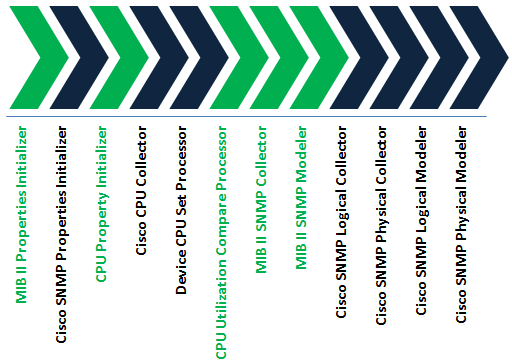2 About the Cartridge Components
This chapter provides information about the components of the Oracle Communications Network Integrity Cisco Router and Switch SNMP cartridge.
The Cisco Router and Switch SNMP cartridge contains the following actions:
Discover Generic Cisco SNMP Action
The Discover Generic Cisco SNMP action scans Cisco devices and provides a physical and logical hierarchical model of what is discovered. This action also models the associations between the physical and logical hierarchies.
This discovery action extends the Discover MIB II SNMP action (from the MIB-II SNMP cartridge) and inherits all its processors. For information about the inherited processors, see Network Integrity MIB-II SNMP Cartridge Guide.
This action also extends the Abstract CPU Utilization Discovery action (from the NetworkIntegritySDK cartridge) to provide CPU utilization enabled discovery. For information about the processors inherited from the Abstract CPU Utilization Discovery action, see Network Integrity Developer's Guide.
The Discover Generic Cisco SNMP action contains the following processors run in the following order:
-
MIB II Properties Initializer (inherited)
-
CPU Property Initializer (inherited)
-
CPU Utilization Compare Processor (inherited)
-
MIB II SNMP Collector (inherited)
-
MIB II SNMP Modeler (inherited)
Figure 2-1 illustrates the processor workflow of the Discover Generic Cisco SNMP action.
Figure 2-1 Discover Generic Cisco SNMP Action Processor Workflow

Description of ''Figure 2-1 Discover Generic Cisco SNMP Action Processor Workflow''
Cisco SNMP Properties Initializer
This processor produces the following data sets:
-
ciscoProductsMap
-
ciscoVendorNumbers
-
ciscoVendorTypesMap
ciscoProductsMap contains a mapping from the vendor-specific portion of the sysObjectId to Cisco device model name.
Example 2-1 provides an example of the ciscoProductsMap file contents.
Example 2-1 ciscoProductsMap File Content Sample
10 = cisco2000
10 - represents the device specific portion of the sysObject (for example, 1.3.6.1.4.1.9.1.10)
cisco2000 - represents the model name
ciscoVendorNumbers contains a list of supported Cisco vendor numbers.
ciscoVendorTypesMap contains a mapping from entPhysicalVendorType to the Cisco equipment part name.
Example 2-2 provides an example of the ciscoVendorTypesMap file contents.
Example 2-2 ciscoVendorTypesMap File Content Sample
1.8 = cevOtherCscLink
1.8 – represents the device specific portion of the sysObjectId (i.e. .1.3.6.1.4.1.9.12.3.1.1.8)
cevOtherCscLink – represents the equipment part name.
Table 2-1 shows a fragment of each data set provided by the Cisco SNMP Properties Initializer:
Table 2-1 Sample Output for Cisco SNMP Properties Initializer
| Sample ciscoProductsMap | Sample ciscoVendorNumbers | Sample ciscoVendorTypesMap |
|---|---|---|
|
1 = ciscoGatewayServer |
9 |
1 = cevOther |
|
2 = ciscoTerminalServer |
4857 |
1.1 = cevOtherUnknownCard |
|
3 = ciscoTrouter |
5771 |
1.2 = cevOtherMoH |
|
4 = ciscoProtocolTranslator |
5842 |
1.3 = cevNmeApaLink |
|
5 = ciscoIGS |
7003 |
1.5 = cevOtherSce8000Scm |
|
6 = cisco3000 |
N/A |
1.6 = cevOtherSce8000Sip |
|
7 = cisco4000 |
N/A |
1.8 = cevOtherCscLink |
|
8 = cisco7000 |
N/A |
2 = cevUnknown |
|
9 = ciscoCS500 |
N/A |
3 = cevChassis |
|
10 = cisco2000 |
N/A |
3.1 = cevChassisUnknown |
|
1294 = ciscoCDScde250 |
N/A |
12.1 = cevMidplaneUmg9820 |
The content of these property files changes occasionally, and they are maintained as part of cartridge revisions. SDK extensions to this cartridge can update the content of the property files. See "About Design Studio Extension."
Cisco CPU Collector
This processor collects the CPU busy percentage value over the past one minute from the device using the cpmCPUTotal1minRev poll list. See "Cisco CPU Collector Poll List" for more information.
Device CPU Set Processor
This processor is used to set the device's CPU utilization threshold value, which is collected by the Cisco CPU Collector.
A device can have multiple CPUs associated with it. In such situations, the average of the usage percentage of all the CPUs is considered and the average value is compared with the user-specified CPU utilization threshold value.
This processor uses the cpuProperties file to set the CPU value of the device in the deviceCPUValue variable. Before extending the CPU utilization functionality, ensure that the device CPU value is set in the deviceCPUValue variable. This value is used as an input for the next processor to compare the CPU utilization value specified by the user and that of the device.
Cisco SNMP Logical Collector
This processor collects Frame Relay, ATM and VLAN media data from the device. See "About Poll Lists."
Cisco SNMP Physical Collector
This processor collects the physical aspects (such as Chassis, Container, Module, Port) of the device. See "About Poll Lists."
Cisco SNMP Logical Modeler
This processor models the data collected from the Cisco SNMP Logical Collector.
Cisco SNMP Physical Modeler
This processor models the data collected from the Cisco SNMP Physical Collector.